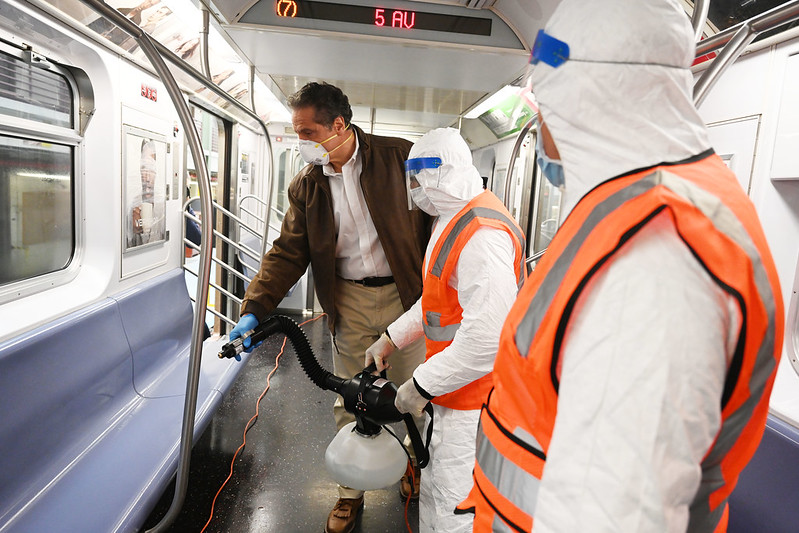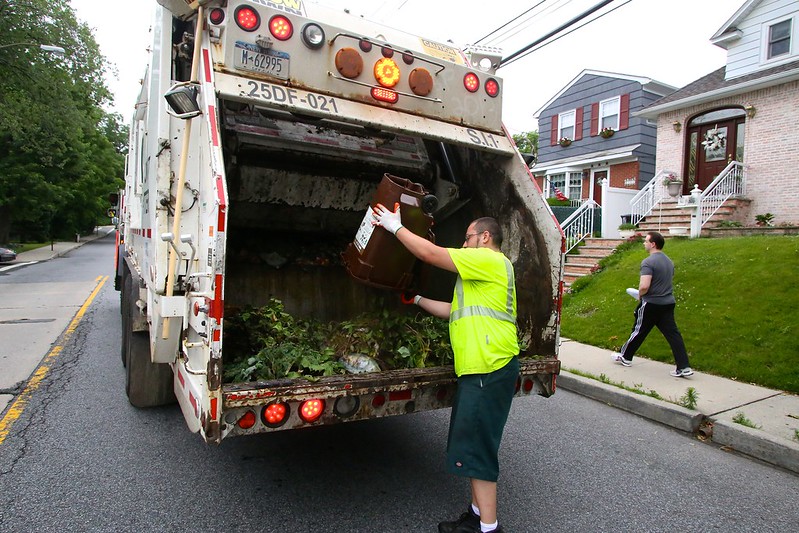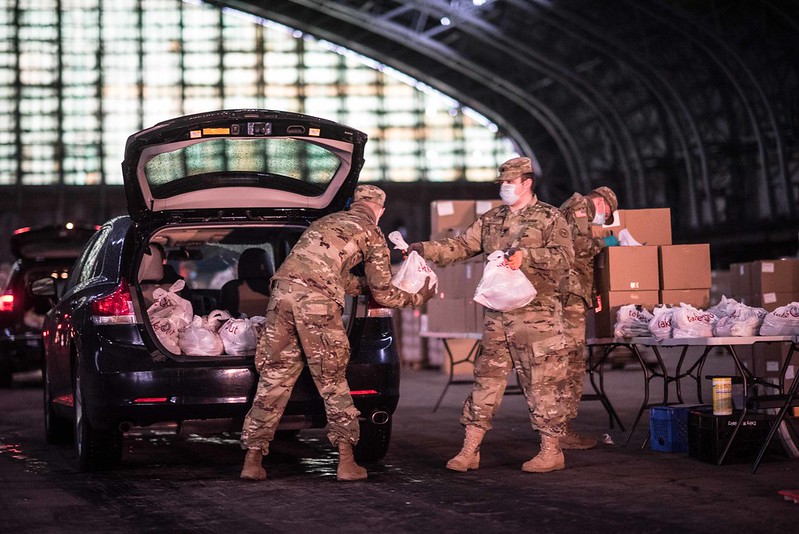Governor Cuomo Owes Subway Riders and Homeless New Yorkers A Housing Plan

Governor Cuomo disinfects a subway car (photo: Kevin P. Coughlin/Governor's Office)
The subway is New York’s circulatory system. If it doesn’t recover, New York won’t. But reopening the subway and the city means more than running more trains: It also means helping homeless New Yorkers who today have nowhere else safe to go.
That is because, as Governor Cuomo demonstrated, the city’s transit crisis is too entwined with its housing crisis for the MTA alone to bring the subway back. In response to the rising number of New Yorkers with no choice but to seek shelter underground, the governor took the most dramatic step he’s taken since putting the state on pause: closing the subway system between 1 and 5 a.m. each night.
The end of 24-hour-a-day subway service made international headlines. In a cruel twist of irony, New York may no longer be the city that never sleeps and at the same time has one less place for unhoused people here to bed down. But closing the subway will not prevent people from sleeping in the transit system, so long as no other safe options are available. To date, the governor and Mayor de Blasio have refused to offer hotel rooms for homeless individuals on the streets or subways who need safe spaces to socially distance and take care of their basic human needs. Although the Mayor has touted that 1,000 people are being moved from congregate shelters to hotel rooms each week, thousands of homeless New Yorkers still face a heightened risk of contracting COVID-19 in congregate shelters -- and those on the streets and subways are not offered these hotel placements directly.
For several decades, as rents have risen, wages have not kept pace. In the past 15 years, New York City has lost more than a million low-rent units, and housing construction for extremely low-income and homeless households has not kept pace with that loss. That inequitable mismatch has increased the number of people who can’t afford a place to live, whether or not they work. Moreover, the shocking economic and health effects of the coronavirus pandemic have forced newly homeless people onto our streets and into the subways.
While New York City maintains a legal right to shelter, the congregate nature of many shelters is simply not safe, as evidenced by the spread of COVID-19 throughout approximately 171 shelters so far. Homeless New Yorkers on the subways know this and are consciously and reasonably refusing to enter shelters and risk their health.
At the same time, New York City needs 24-hour subway service. A significant number of riders -- many of them essential workers -- depend on the subway for travel between 1 and 5 a.m. and have no other option. Essential workers in health care, food service, building services, and more ride transit overnight while the rest of us sleep. Overnight subway service is essential to restore our 24-hour economy as soon as is safely possible. A full recovery is unimaginable without it.
Meanwhile, daytime service, which moved several million people daily for more than a century until March, will falter if crowding is unmanageable as New York reopens. As more New Yorkers return to work, the ability to maintain social distance on the commute is key. Governor Cuomo must ensure subway riders have more space than before. But to reliably limit crowding and keep both homeless and housed New Yorkers safe, he will also need to safely house people who have had to resort to sheltering inside subway cars.
The answer to homelessness in our transit system is not to drive people off the subway and further into the shadows, further from the help they so desperately need. The answer is to offer them safe temporary shelter and permanent housing. Right now, the city and state are deploying NYPD, MTA Police, and outreach workers to clear trains at night and offer “services.” These services are in the vast majority of cases a transport to an unsafe congregate shelter. Many individuals on the trains are aware of the risks of COVID-19 in shelters and take their chances on the streets instead.
City Council Speaker Corey Johnson and Council Member Stephen Levin recently proposed opening the city’s more than 100,000 empty hotel rooms to homeless people. This sensible option can provide the safe, private accommodations everyone needs to ride out the pandemic. With no indication when tourism will return, allowing homeless individuals on the streets and in the transit system to immediately access hotels is a creative, humane, and efficient way to match surplus with need. It is the right thing to do.
Similarly, state legislators led by Assemblymember Andrew Hevesi and Senator Liz Krueger have long advocated for state-funded housing vouchers to move people off streets, out of shelters and other public spaces, and into homes of their own. The Home Stability Support program and more permanent supportive housing would put state resources behind ending one of the harshest manifestations of life in the most unequal state in the nation.
In the coming weeks, these worthy proposals should form the basis of a housing plan fit for the subway that will keep riders safe. To reopen New York to everyone, around the clock, Governor Cuomo must seize the moment to meet New Yorkers’ housing needs.
***
Danny Pearlstein is Policy Director at the Riders Alliance. Giselle Routhier is Policy Director at Coalition for the Homeless. On Twitter @dannypearlstein & @RidersAlliance & @giselle_ashley & @nyhomeless.
***
Have an op-ed idea or submission for Gotham Gazette? Email This email address is being protected from spambots. You need JavaScript enabled to view it.
New York City Must Keep and Expand Organics Collection, It’s an Essential Service

Organics collection (photo: NYC Department of Sanitation)
Among the businesses listed as essential in Governor Cuomo’s PAUSE order are "trash and recycling collection, processing, and disposal" industries. Yet on April 7, Mayor de Blasio followed a different interpretation by announcing that the Department of Sanitation’s organics recycling program would be eliminated on May 4. To do away with this critical environmental program just to save a miniscule percentage of the city’s budget doesn’t make sense, and here’s why:
While it is no secret that the city’s curbside organics collection program doesn’t pay for itself, that’s only half the story. It is true that the program currently generates a small amount of revenue, about $50,000. However, if properly executed, the program has the potential to generate millions of dollars in revenue for the city.
In a February 2019 study, "How Much Potential Revenue are New Yorkers Wasting by Trashing Organics?," the city’s Independent Budget Office calculated that if all of the 1 million tons of food and yard waste generated by New Yorkers annually were recycled into compost, it could produce $12.5 million in revenue. If the same annual tonnage were recycled into biogas and used to generate electricity, the potential revenue could be as much as $22.5 million.
We can only realize the untapped financial potential of the organics program if enough New Yorkers separate their leftover pizza crusts and banana peels from their trash and into the city's brown bins. Cutting the program nixes the opportunity for that to happen and washes away years of gains in a single stroke. What the city should do is pursue an "expand to save" model, accomplishing multiple goals at once.
Realizing the increased revenue from organics recycling is dependent upon expansion. An investment in our organics program now will save money in the long run, all while helping our planet. It’s a win-win.
Furthermore, history suggests that eliminating the program now means it will be that much harder to bounce back if it is ever restored. When the Bloomberg administration suspended plastics and glass recycling in 2002, in the midst of another recession, New Yorkers were recycling at a rate of about 20%. Recycling has never returned to the same level after it was brought back; the latest available data, from fiscal year 2019, shows an 18.1% recycling diversion rate citywide, a decade and a half after. Changing habits is hard.
Loss of New York City’s composting program would also have implications for the cleanliness of our city. This could mean an uptick in rats and other vermin. Currently, buildings that participate in the curbside organics collection program store their food scraps in rat-proof brown bins provided by the Department of Sanitation. Once brown bin collection stops, the same amount of organics will end up in garbage bags stacked on sidewalks, a ready feast for rats. To make matters worse, the mayor has also proposed eliminating fourth-day garbage collection in "Rat Zones."
Ending the curbside collection of organics is short sighted and ill-advised. It’s penny-wise and pound-foolish in a time when we desperately need to be thinking about how to build a resilient city. The health and longevity of our neighborhoods, city, and planet should be paramount, especially in times when tough decisions need to be made about our city’s budget and how the fiscal decisions we make today will impact our future.
The CORE Act, being introduced on Wednesday by City Council Members Keith Powers and Antonio Reynoso (a co-author here), would provide New Yorkers with places to drop off organics, electronics, textile, and other materials for recycling, as an interim measure until we restore and expand curbside collection of these streams to all New Yorkers. We know from recent history that the relatively little we save with a cut like this doesn’t justify the decades it will take to rebuild the good that it does for New Yorkers.
***
Gale Brewer is the 27th Borough President of Manhattan. City Council Member Antonio Reynoso represents parts of Brooklyn and Queens and chairs the Council’s Committee on Sanitation and Solid Waste Management. On Twitter @galeabrewer & @CMReynoso34.
***
Have an op-ed idea or submission for Gotham Gazette? Email This email address is being protected from spambots. You need JavaScript enabled to view it.
Coronavirus Shows Just How Much the Census Counts

Federal aid to New York City is even more urgent than ever (photo: Michael Appleton/Mayor's Office)
While many of our daily activities remain on hold, the 2020 Census must still be taken and completed this year. Not only is it required by the U.S. Constitution, but there is a tremendous amount at stake for New York, including billions of dollars in federal aid, a fair allocation of seats in Congress, and accurate representation in state and local government. From road repairs to education and social services, over 300 federal programs are driven by census data.
Through my work at New York Law School and the statewide New York Counts 2020 census coalition, I have been collaborating with New Yorkers on best practices and strategies to ensure an accurate census count. What we cannot overlook—especially now—is that the census is critical to protecting us from future pandemics. An accurate census count is crucial to securing enough hospitals, medical facilities, doctors, nurses and medical supplies so that we’ll never again see the kinds of shortages we are seeing today. That’s because health care providers, insurance companies, and government officials all make important decisions on where to provide resources and assistance based on census data.
Unfortunately, while this year’s count is especially important, it’s also far more challenging than any in our country’s history. And right now, New York is lagging behind other states. As of May 8, only 52.4 percent of New York State’s households have responded in the first few weeks of the census counting process, placing New York 42nd among the 50 states.
The census has never been a perfect count. In fact, well before COVID-19 struck, the Urban Institute estimated that New York could be undercounted by 313,700 people this year. That’s almost half the population of one of our congressional districts.
But COVID-19 puts us in danger of a far more severe undercount that will impact our state for years to come. Some of lowest response rates are in communities hit hardest by COVID-19, the result of income and racial inequality. These are the same areas that have also been historically undercounted and neglected, and without an accurate count, they will not receive adequate government support.
Everyone has a role to play in the solution: our government leaders, community organizations, experts, and fellow New Yorkers. Since person-to-person outreach cannot take place, outreach groups must rely on text messages, phone banking, emails, Zoom sessions, and postering to reach communities that have been historically undercounted. I’m encouraged to see several areas asking grocery stores and other essential businesses to place 2020 Census flyers in bags as a reminder. These are the kinds of actions we need now.
While I applaud the U.S. Census Bureau for extending the counting period until October 31, with so much uncertainty due to COVID-19, this still may not be enough time. If census workers are not able to visit homes directly, then we will need to build new strategies to reach people through social distancing, media, and other creative methods never tried before.
With so much at stake depending on an accurate census, everyone who can respond must do so. Census information cannot be shared with any other government agency, and there is no citizenship question. It’s easy to fill out and can be done online, over the phone, or by mail.
Now more than ever, answer the census. Take 10 minutes to answer 10 questions, which will help New York for 10 years.
***
Jeffrey M. Wice is an Adjunct Professor and Senior Fellow at New York Law School and head of the school’s New York Census and Redistricting Institute. On Twitter @JeffWice.
***
Have an op-ed idea or submission for Gotham Gazette? Email This email address is being protected from spambots. You need JavaScript enabled to view it.




